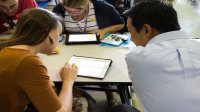Doing More With Less: PD, Resources, and Ownership
Strategies for doing more with less include adequate PD around new technology, embracing mobile solutions, low-cost high tech, and expanding the ownership of school policy making.
In my previous post, I wrote about embracing technology's big new possibilities in education through smaller-scale changes that we can implement right now for our students' benefit. I'd like to continue with a few more thoughts on this subject, once again in the spirit of starting conversations in your school or district (as well as in the comments section of this post).
1. Training Is Key
Technology in the classroom brings out interesting things in teachers. Some, like myself (and likely you as well), are eager to learn and do more because the technology and its uses interest us. Others are uncertain but willing to learn if given some help. And, sadly, some people write off technology as a chore or passing fad.
One way to ensure that technology is used properly in the classroom is to make it clear how to do so. Training should be quality and continuous. Schools must make it a priority to help educators use the "stuff" that they buy for them.
But these ideas involve dedicating extra time, which isn't always easy to come by. I recommend a grassroots approach. Tech Tips are short emails that I've been sending around at my job for the past four years, explaining what a tool, resource, or website does and why it might be useful. These emails don't take long to write, but are often seen as very helpful. If you start the practice and get a few interested readers, you'll probably have a fun sharing circle right away.
My Advice
Look outside your school for PD.
Some great professional development is free and easy to come by. Throughout the country, there are wonderful un-conferences that focus on educational technology, including EduCon or EdCamp. But the internet is one of the best places to seek advice and ideas. Using YouTube videos and tutorials as well as Twitter, you can connect with other educators to learn -- and share -- just about anything.
Suggest that each faculty meeting include a tech-share.
Allow teachers to explain their hits and misses using technology in the classroom.
Make sure that training is more constant.
When new technology arrives in a classroom or school, the training should be more than just a one-off when everything gets set up. Teachers need support to learn how to best use the new tools with their curriculum.
2. Go Mobile
Technology has come a long way. We could once access the internet only through a giant tower machine with a clunky monitor, and now we can get online with anything from a smartphone to an iPad. As a result, the days of computer labs are over. Indeed, they're a waste of space in a modern-day school. Why make teachers leave their classrooms just to use technology as part of a lesson? Any technology investment that a school makes should be something useful in multiple settings for multiple purposes by multiple sets of students.
My Advice
Make the case for mobile technology.
In some cases, the people making decisions about what to acquire for your school might not actually be familiar or comfortable with some of the newest technology. While schools always should exercise a modicum of caution when evaluating new tech, all too often they seem to go with what's easiest, cheapest, or most comfortable for the decision makers. Show these individuals what you want, and explain why it's the best solution out there. If you want an iPad cart for your class, don't just ask for one -- make a case as to why your classroom would be a better place if you had it in there.
Fundraise creatively.
Sometimes money is an issue, and the school won't underwrite a tech initiative, however valid. Grants and donation sites are great places to post any projects that you're working on or toward. DonorsChoose.org and DigitialWish.com are two excellent websites where teachers can propose a project that they're developing and ask for funds to help them acquire supplies and equipment.
3. High Tech on a Low Budget
Educational technology should no longer be synonymous with large expenditures for software and hardware. Schools can do a great deal with very little. With web access, students and teachers have access to thousands of free resources that can provide countless enhanced learning experiences and ways for students to create a flood of creative content. For example, SumoPaint is a robust image editor which looks almost identical to PhotoShop -- but it's free to use and can be accessed by anyone. This is a key benefit of web-based tools, which aren't machine or platform dependent.
My Advice
Use Twitter.
Twitter is one of the best places to learn about these new free web tools quickly and efficiently. In addition, there are lots of great sites dedicated to finding and sharing free web tools with the user. For example, I run a social bookmarking site called eduClipper, where you can quickly search for or stumble upon a great new tool to use in your classroom.
4. Rethink Who Should Be at the Table
When school policy and visions are planned, there often seems to be a major disconnect between the administration (usually the ones making or voting on the policy) and the rest of the school (the teachers and students whom the decisions affect). Why not try to change that?
We really do teach in a remarkable time. Each day when you walk into your school setting, whether it be a classroom, office, or somewhere else, remember that you help to shape the future, and what you do today can change the world!
These are just a few ideas. How can you start making changes right now?
